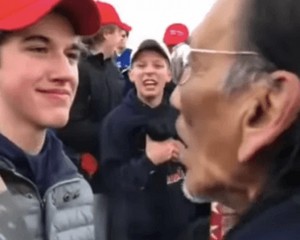 ast week a Covington Catholic School student wearing a MAGA hat was taunted by an
American Indian and then falsely blamed for it. It was a classic
example of fake news. But even more so is it a case of people believing they can
determine a person's thinking by his facial expression. In the student's case, it was
his smile. Conservatives saw it as tolerant, bemused, and beatific. Liberals saw it
as an evil “smirk” and were literally enraged by it.
ast week a Covington Catholic School student wearing a MAGA hat was taunted by an
American Indian and then falsely blamed for it. It was a classic
example of fake news. But even more so is it a case of people believing they can
determine a person's thinking by his facial expression. In the student's case, it was
his smile. Conservatives saw it as tolerant, bemused, and beatific. Liberals saw it
as an evil “smirk” and were literally enraged by it.
This being the Twitterzoic Era, the rage was instant and unconstrained by reason. One movie producer said the kid should be thrown in a woodchipper. Reza Aslan, a former CNN commentator noted for partaking in cannibalism, tweeted “Have you ever seen a more punchable face than this kid's?” A strange person named Kathy Griffin called the students “f***ers” [letters not starred out in the original] and demanded they be doxxed. The mob complied and doxxed the wrong person, ruining the person's wedding.
Nicholas Frankovich of the anti-Trump magazine National Review said the students “might as well have just spit on the cross” and compared them to the people humiliating Jesus in the final hours before his crucifixion. Others threatened the students and their school had to be closed for safety.
Some of these posts were later taken down or even apologized for when the true story came out. But they testify to the power of facial expressions to provoke rage and racial hatred.

The famous picture of the Covington Catholic School student. The attacker's expression is not visible.
The expression was a taut smile, suggesting stress and mild amusement, with no hint of any fear or anger. But political left-wingers and former TV actresses saw it as a taunting expression and unanimously reacted to it with anger and rage.
What is a “smirk” and why does it evoke such outpourings of rage?
There's a big literature in social psychology about facial expressions. Facial expressions are a form of communication. People decide on the meaning of an expression within one second, and automatically ‘mimic’ the expression in the process of emotional contagion.
Shlomo Hareli et al. found that subjects always interpret an angry expression as a sign of power.[1] This might be why political activists always portray themselves as angry about whatever they're protesting against. By contrast, expressions of fear or sadness are taken as a cue that the person has low social power. Thus, a courageous or non-fearful response to threat is taken as an assertion of power. Hareli writes:
A person showing anger was perceived as having more social power when this anger was responded to with fear or sadness than when it was responded to with neutrality or anger.
In a dyadic interaction, reactions that signal social dominance, such as anger and happiness, reduce the perception that the aggressor has power. Happiness signals that the person believes all is well and is mocking or denying the relevancy of the attacker's attempt to signal high power.
The student's case shows that the reverse is also true. If observers think the person is powerful and threatening, they are more likely to misinterpret his expression as one of contempt or hatred. The news media appear to believe there is some connection between a red MAGA hat and views they consider threatening. Their conditioned response to the hat, which appears comical to conservatives, is a classic reaction to perceived out-group threats.
Mondillon et al.[2] found that people perceived expressions of anger displayed by in-group and out-group members differently. Out-group faces take longer to process, so subjects incorrectly perceive the duration of out-group expressions to be longer.
Thus, the real reason for the rage was that the Twitterers expected a more submissive response. They misinterpreted the student's facial expression as contemptuous because they saw him as a member of an out-group that threatened their power and status. It is a classic case of how preconceived notions, and failure to portray the facial expressions of both parties in an argument, can have major political ramifications. ★
1 Hareli S et al (2018). Dyadic dynamics: the impact of emotional responses to facial expressions on the perception of power. Front Psychol 9, 1993. PMID 30410457, Full text link
2 Mondillon et al, Soc Neurosci 2007 2, 223–237 PMID 18633817 (paywalled).
jan 24 2019, 6:40 am. edited jan 24 2019 6:15 pm
